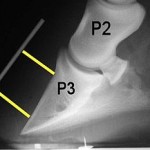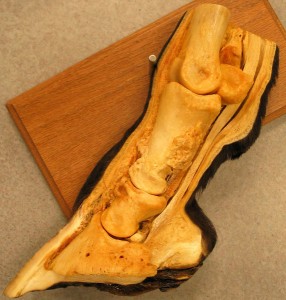“It sounds like this horse is suffering from significant laminitis….“What are the symptoms for founder?”When a horse or foal gets founder, what are the symptoms…?”

“What are the symptoms for founder?”
How do you treat them before the vet gets there to do the real work? And what would a vet do to treat them?
Dr. Cheryl Rahal’s Answer:
Nakita,
Founder or Laminitis is pain and inflammation of the lamina of the hoof. The lamina is the sensitive tissue that produces the corn of the hoof, much like your finger nail and the bed of tissue under your nail. Laminitis is caused by a number of things, such as toxins, fevers, hormones or endocrines involved with obesity, heat and concussion forces. The symptoms are almost always limited to the front feet and consist of treading back and forth from foot to foot, walking like on eggshells, a camped under hind end with front limb toes pointed out, and bounding pulses in the feet. There are a number of treatments for laminitis and new therapies arising yearly. The best triage treatment is to minimize movement or walking and to ice the hoof wall while awaiting veterinary advice. I hope this answers your questions. Good luck.
“When a horse or foal gets founder, what are the symptoms…?”
Dr. Jack Sales’ Answer:
The horse is in a lot of pain, the pain is coming from the front hooves normally. So the signs of a horse with founder will include the horse being very reluctant to walk, when he does walk, he will act like he is walking in egg shells, putting weight on his front feet very reluctantly. He will be tucked under behind, as if he would want to put most of his weight on his hind limbs. He will normally have excessive heat in his front feet and will show an increased pulse pressure in the arteries going to his feet. Both of these conditions are emergencies, and would warrant a call to your veterinarian for advice and assistance. Thanks for the question.
“It sounds like this horse is suffering from significant laminitis….”
Hi Bill!
My brother is caring for a rescue horse for the local humane society. She is an aged large pony. Her feet were horrendous, turned up in the front like a elf! I own and show quarter horses so I sent my farrier out and he trimmed her feet and will continue but the problem is she has developed diarrhea… she has a mineral block (she actually bites chunks off of it to get more) about 1 cup a sweet feed per day (2 feedings) unlimited hay, 1/2 gram of bute 2 x per day. She also drinks water excessively… anytime you put a 5 gallon bucket down in front of her she won’t stop until it is all gone… He is giving her about 10 gallons a day but only lets her drink about 2 gallon at a time. He has been caring for her for about 3 weeks now, she was dewormed with ivermectin about 1 and 1/2 weeks ago. The only thing found in her manure afterward was a 1 bot worm. I gave him some electrolytes to put in her water yesterday and he said she drank it right down. I told him to stop everything except hay and water and see if the diarrrhea clears up. Including the mineral block. What would you advise for this mare? She is about 500 lbs just skinny… I can see all of her ribs.. the main abuse was her feet. she is still very very sore on her feet.. please help! Thanks you so much.
Dr Bill Schurg’s Answer:
Claudia:
It sounds like this horse is suffering from significant laminitis. You have done well to get farrier help. This horse will need to be carefully fed a diet of primarily grass hay. Since the laminitis has been so severe and can’t be compromised at this point feeding or offering a high fat low starch diet may be useful. The use of a wet bran mash carrier with a fat supplement could be used as well. The use of rice bran beet pulp and vegetable oil mixed into the wet bran mash might be considered as well. If you have not had a comprehensive vet check that should be done as well. Checking this horses teeth and even looking to see if the horse has Cushing disease may be helpful. It will take several months of careful and constant care to get this animal back on the road to a more normal equine life.
“She can’t stand. She is breathing funny. A vet said it’s from a number of things…”
My horse has fallen sick. I’m not sure what it is. She can’t stand. She is breathing funny. A vet said it’s from a number of things. Working without walking. Too much oats. Overheating. They said she wont get better without shots. But she is pregnant. They said that the shots would kill the baby. Have you heard of such symptoms?
Dr. Jack Sales’ Answer:
Hi Christine,
It sounds as if your Vet suspects founder (Laminitis), which is a very serious disease. It can be caused by a number of things, as they explained. It is unfortunate that the treatment for this ailment could do harm to the baby, but the alternative would be to take a chance on losing the Mare and the baby if she is not treated. Your Vet is going to do the best he/she can do so you need to support this and work with her/hem.
“My 5 yr old Thbd was just diagnosed with laminitis…”
My 5 yr old Thbd was just diagnosed with laminitis (I’m not certain of the severity, but we did catch it quickly) and did founder a bit. Right now he is on stall rest, bute and ace, and his feet have been padded and wrapped. His grain has been cut in half but he is getting plenty of hay. Anything else you would suggest I do? I’ve heard a bit about laminasaver. I just feel like I’m not doing enough….
Dr. Jack Sales’ Answer:
Hi Blair,
I am sorry to hear that your horse has developed Laminitis. The use of Bute and ace at this stage is the most important thing that you can do in that these treatments will hopefully reverse the disease or stop it. The support for the feet by padding and wrapping is also very helpful in minimizing the damage that can occur to the feet. Lamina saver is a medication that purports to supply nitric oxide to the tissues of the feet, which could aid the lamina in recovering the blood supply back to normal. It would be worthwhile to use this if your attending Veterinarian agrees. Isoxuprine is another drug that has shown to improve circulation in the feet and may be helpful in laminitis. Talk to your Veterinarian about these methods and others that you may have heard of that help founder and as a team, your Vet and you can decide what is best for your particular horse’s situation.
“I have a thoroughbred mare that has foundered…”
I have a thoroughbred mare that has foundered due to free feeding while out to pasture for two years. Her previous owners say they caught it and treated it before it got too bad. What type of work can I do with her?
Dr. Cheryl Rahal’s Answer:
Many horses that ‘founder’ or have an acute case of laminitis, can be treated and not have any lasting changes or debilitating secondary conditions due to the laminitis, and can continue to be used as they were previously. But other horses who have a severe and or long standing bout of laminitis may have changes, such as a rotated or sunken coffin bone, pedalosteitis (inflammation of the coffin or pedal bone), or abnormal growth to the corn of the hoof wall. It is these changes and the degree of change that affects soundness. So really to answer your question, I have questions for you…… is she sound now, does she have any lameness or tenderness to her feet?, does she have any abnormal hoof growth, and have x-rays been taken to assess her coffin bone and its relation to the hoof wall? You may need to counsel with your veterinarian to gain answers to these question, and guidance on what type of work she will be able to handle.






















